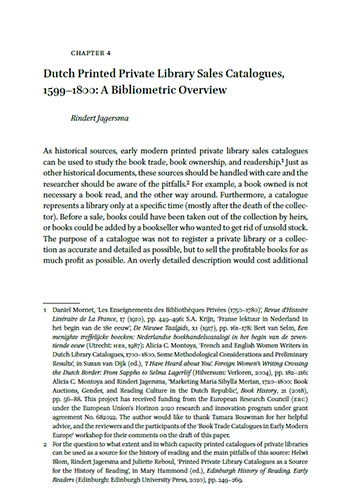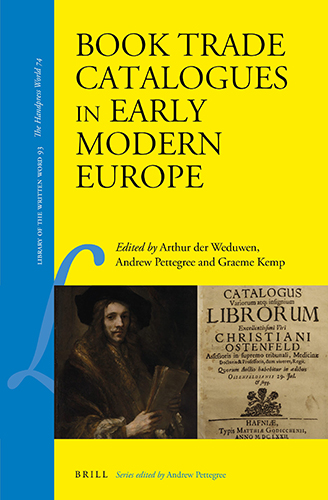

Rindert Jagersma
Dutch Printed Private Library Sales Catalogues, 1599–1800: A Bibliometric Overview
In: Arthur der Weduwen, Andrew Pettegree, and Graeme Kemp (eds.), Book Trade Catalogues in Early Modern Europe (Leiden : Brill, 2021), pp. 87-117.
Chapter 4 | Library of the Written Word (LWW), volume: 93.
ISBN: 978-90-04-42223-0 (hardback) | 978-90-04-42224-7 (e-book, PDF)
DOI: https://doi.org/10.1163/9789004422247_005
Link: https://brill.com/view/book/edcoll/9789004422247/BP000013.xml
Abstract:
The aim of this bibliometric study is to analyse the 4,756 Dutch book sales catalogues from ‘Book Sales Catalogues of the Dutch Republic, 1599–1800’. The metadata provides information about the catalogues, collectors, and auctions and allows for a large-scale study of the development of the book sales catalogue to the year 1800 which can offer insight in book collecting, readership, and the second-hand book market. By analysing the database, we can explore the size of catalogues, collectors, and the locations of the auctioned collections. This allows us to gain insight into the phenomenon of the Dutch printed book sales catalogue, and more specifically the ‘private library sales catalogue’, in the seventeenth and eighteenth century.
This article is Open Access available.
Link to volume: https://brill.com/view/title/56837
Read online: Full Text
Direct download: PDF (0,8 MB)
This publication was the result of a workshop at the University of St Andrews in June 2018. The article is a product of the MEDIATE project.
Abstract of volume:
This edited collection offers in seventeen chapters the latest scholarship on book catalogues in early modern Europe. Contributors discuss the role that these catalogues played in bookselling and book auctions, as well as in guiding the tastes of book collectors and inspiring some of the greatest libraries of the era. Catalogues in the Low Countries, Britain, Germany, France and the Baltic region are studied as important products of the early modern book trade, and as reconstructive tools for the history of the book. These catalogues offer a goldmine of information on the business of books, and they allow scholars to examine questions on the distribution and ownership of books that would otherwise be extremely difficult to pursue.